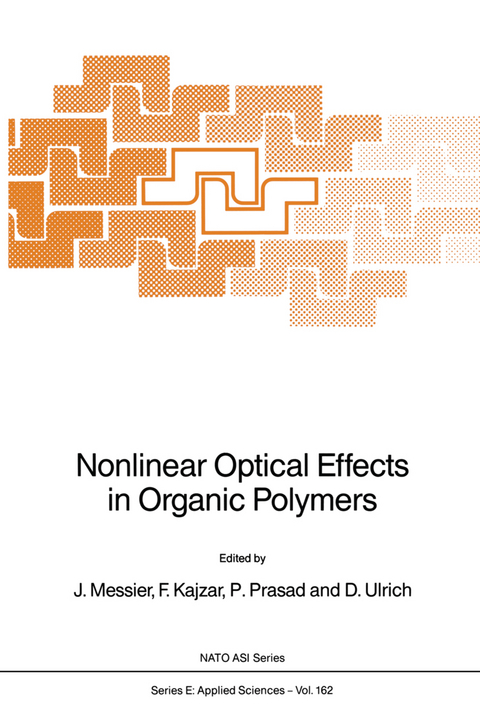
Nonlinear Optical Effects in Organic Polymers
Springer (Verlag)
978-94-010-7530-5 (ISBN)
Photonics, the counterpart of electronics, involves the usage of Photons instead of electrons to process information and perform various switching operations. Photonics is projected to be the technology of the future because of the gain in speed, processing and interconnectivity of network. Nonlinear optical processes will play the key role in photonics Where they can be used for frequency conversion, optical switching and modulation. Organic molecules and polymers have emerged as a new class of highly promising nonlinear optical materials Which has captured the attention of scientists world wide. The organic systems offer the advantage of large nonresonant nonlinearities derived from the 1T electrons contribution, femtosecond response time and the flexibility to modify their molecular structures. In addition, organic polymers can easily be fabricated in various device structures compatible with the fiber-optics communication system. The area of nonlinear optics of organic molecules and polymers offers exciting opportunities for both fundamental research and technologic development. It is truly an interdisciplinary area. This proceeding is the outcome of the first NATO Advanced Research WOrkshop in this highly important area. The objective of the workshop was to provide a forum for scientists of varying background from both universities and industries to come together and interface their expertize. The scope of the workshop was multidisciplinary with active participations from Chemists, physicists, engineers and materials scientists from many countries.
Theory of Nonlinear Polarizability in Organic Low Dimensional Systems.- Impact of Dimensionality in the Optical Nonlinearities.- Theoretical Design of Organic Molecules and Polymers for Optoelectronics.- Structural Relaxation and Nonlinear Zero-Point Fluctuations as the Origin of the Anisotropic Third-Order Nonlinear Optical Susceptibility in Trans-(CH)x.- Nonlinear Susceptibility of Organic Systems.- Third-Order Nonlinear Susceptibility in Semiconducting Polymers.- Recent Nonlinear Optical Studies of MNA and Conjugated Linear Chains.- Quadratic Nonlinear Behaviour of Various Langmuir-Blodgett Molecules.- Prediction of Third Order Nonlinear Optical Activity in Ordered Polymers.- Effect of ?-Electron Delocalization on the Second-Order Polarizability of Disubstituted Hydrocarbons.- Synthesis and Nonlinear Optical Properties Characterization of New 1-D Conjugated Polymers.- Studies of Structure-Property Relations.- Synthesis of new Nonlinear Optical Ladder Polymers.- Nonlinear Optical Properties of poly(p-Phenylene Vinylene) thin Films.- The Synthesis and Properties of some Novel Diacetylene Monomers and Polymers.- Design and Optical Properties of a low Energy gap Conjugated Polymer: Polydithieno (3,4–b:3’,4’–d)Thiophene.- Synthetic Approaches to Stable and Efficient Polymeric Frequency Doubling Materials. Second-Order Nonlinear Optical Properties of Poled, Chromophore-Functionalized Glassy Polymers.- Langmuir-Blodgett Films of Rigid rod Polymers with Controlled Lateral Orientation.- Polymers and Molecular Assemblies for Second-Order Nonlinear Optics.- Spectral Properties and Second-Harmonic Generation of Hemicyanine dye in Langmuir-Blodgett Films.- Experimental Methods.- Cubic Susceptibility of Organic Molecules in Solution.- Measurement of the Non-LinearRefractive Index of some Metallocenes by the Optical Power Limiter Technique.- Polymerization and X-ray Structure of new Symmetrical and Unsymmetrical Diacetylenes.- Application of Organic Polymers in NLO Devices.- Third-Order Nonlinear Guided-Wave Devices.- Organic Integrated Optical Devices.- Orientationally Ordered Nonlinear Optical Polymer Films.- Overview-Nonlinear Optical Organics and Devices.- Non Linear Optical Polymers for Active Optical Devices.- Linear Electrooptic Coefficient of a Ferroelectric Polymer.- Application of Third-Order Non-Linearities of Dyed PVA to Real-Time Holography.- Device Applications and Materials Requirements.- Ultrafast Third-Order Non-linear Optical Processes in Polymeric Films.- Picosecond Phase Conjugation in Yellow Polydiacetylene Solutions.- Picosecond Studies of Optical Stark Effect in Polydiacetylenes.- Four Working Groups Reports.- Ultrafast Phenomena in Conjugated Polymers.- Device Applications and Materials Requirements.- Polymer Synthesis for Nonlinear Optics and Characterization.- Characterization Techniques.
| Reihe/Serie | NATO Science Series E ; 162 |
|---|---|
| Zusatzinfo | XIV, 396 p. |
| Verlagsort | Dordrecht |
| Sprache | englisch |
| Maße | 160 x 240 mm |
| Themenwelt | Naturwissenschaften ► Chemie ► Organische Chemie |
| Naturwissenschaften ► Chemie ► Physikalische Chemie | |
| Naturwissenschaften ► Physik / Astronomie ► Optik | |
| Technik ► Elektrotechnik / Energietechnik | |
| ISBN-10 | 94-010-7530-1 / 9401075301 |
| ISBN-13 | 978-94-010-7530-5 / 9789401075305 |
| Zustand | Neuware |
| Haben Sie eine Frage zum Produkt? |
aus dem Bereich


